
The Aizoaceae, or fig-marigold family, is a large family of dicotyledonous flowering plants containing 135 genera and about 1800 species. They are commonly known as ice plants or carpet weeds. They are often called vygies in South Africa and New Zealand. Highly succulent species that resemble stones are sometimes called mesembs.
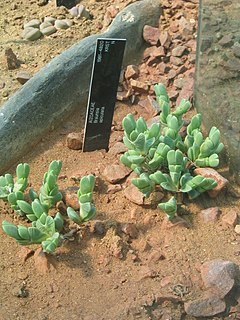
Braunsia is a genus of succulent plant in the family Aizoaceae, indigenous to the Western Cape province in South Africa.

Mesembryanthemum is a genus of flowering plants in the family Aizoaceae; like many members of this family, it is characterized by long-lasting flower heads. Flowers of Mesembryanthemum protect their gametes from night-time dews or frosts but open in sunlight. There is an obvious evolutionary advantage to doing this; where sun, dew, frost, wind or predators are likely to damage exposed reproductive organs, closing may be advantageous during times when flowers are unlikely to attract pollinators. It is indigenous to southern Africa.

Nicholas Edward Brown was an English plant taxonomist and authority on succulents. He was also an authority on several families of plants, including Asclepiadaceae, Aizoaceae, Labiatae and Cape plants.
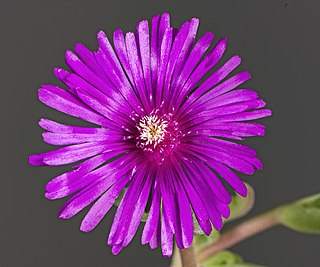
Delosperma is a genus of around 100 species of succulent plants, formerly included in Mesembryanthemum in the family Aizoaceae. It was defined by English botanist N. E. Brown in 1925. The genus is common in southern and eastern Africa. Delosperma species, as do most Aizoaceae, have hygrochastic capsules, opening and closing as they wet and dry.

In botany, succulent plants, also known as succulents, are plants with parts that are thickened, fleshy, and engorged, usually to retain water in arid climates or soil conditions. It is a characteristic that is not used scientifically for the definition of most families and genera of plants because it often can be used as an accurate characteristic only at the single species level. The word succulent comes from the Latin word sucus, meaning 'juice', or 'sap'. Succulent plants may store water in various structures, such as leaves and stems. The water content of some succulent organs can get up to 90–95%. Some definitions also include roots, thus geophytes that survive unfavorable periods by dying back to underground storage organs may be regarded as succulents. In horticultural use, the term succulent is sometimes used in a way that excludes plants that botanists would regard as succulents, such as cacti. Succulents are often grown as ornamental plants because of their striking and unusual appearance, as well as their ability to thrive with relatively minimal care.

Mesembryanthemum cordifolium formerly known as Aptenia cordifolia is a species of succulent plant in the iceplant family. The common names of the plant include baby sun rose, heart-leaf, red aptenia or aptenia in English, as well as rooi brakvygie or brakvygie in Afrikaans, and umjuluka, ibohlololo, or uncolozi omncane in isiZulu in South Africa. It is known as heartleaf iceplant in the USA British names may be heart-leaved aptenia or heart-leaved midday flower because, like many other representatives of the Aizoaceae, it opens its flowers only during the sunshine of the day. It is a creeping plant that forms a carpet of flat-growing perennial herbs in groups on the ground from a base. Genus name means middle-embryo flower in reference to the position of the ovary in the flower. The specific epithet is derived from Latin for heart-shaped leaves.
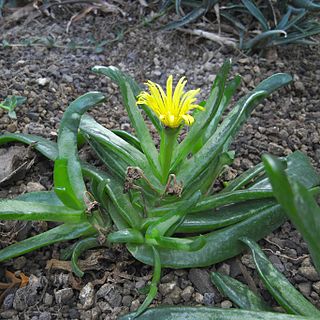
Glottiphyllum is a genus of about 57 species of succulent subtropical plants of the family Aizoaceae. It is closely related to the Gibbaeum and Faucaria genera. The name comes from ancient Greek γλωττίς glottis "tongue" and φύλλον phyllon "leaf". The species are native to South Africa, specifically to Cape Province and the Karoo desert. They grow in rocks and soils incorporating slate, sandstone and quartz. Rainfall in their native areas is between 125 and 500 mm, most of which falls in March and November.
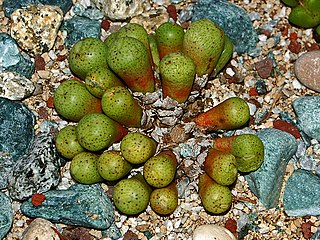
Conophytum jucundum is a species of succulent plants belonging to the family Aizoaceae. As its synonym Conophytum gratum, the pleasing cone plant, it has gained the Royal Horticultural Society's Award of Garden Merit.
Cylindrophyllum comptonii is a species of succulent plant belonging to the genus Cylindrophyllum of the family Aizoaceae. It is endemic to South Africa.
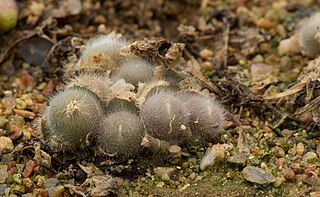
Conophytum stephanii is a small South African species of Conophytum succulents named after German plant collector Paul Stephan, who tended the succulent collection at the Hamburg Botanic Garden in Hamburg, Germany. The plant was first described by Dr. Schwantes in 1929 and published in "Die Gartenwelt" 33:25.
Gunniopsis calva, commonly known as the smooth pigface, is a succulent plant in the iceplant family, Aizoaceae. It is endemic to Australia.
Vlokia ater was the first species described for the genus Vlokia in the Aizoaceae plant family. The genus name honors the discoverer, South African botanist, Jan H. J. Vlok (1957-). The species name derives from the Latin adjective "ater" for "black" and refers to the black coloring which older leaf leaves assume.
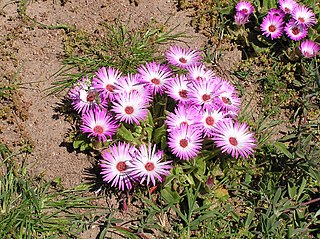
Dorotheantheae is a small tribe of annual succulents in the Aizoaceae subfamily Ruschioideae. Though it originally comprised three genera, Cleretum remains as the only recognised genus. Dorotheantheae are endemic to the western and south-western parts of South Africa. The type genus is Dorotheanthus, despite it being no longer recognised.
Hartmanthus is a genus of tropical, succulent flowering plants in the family Aizoaceae, native to the lower Orange River in ǁKaras, Namibia and Northern Cape, South Africa.

Trichodiadema densum is a succulent flowering plant in the fig-marigold family Aizoaceae, native to the Western Cape Province, South Africa.

Cephalophyllum purpureo-album is a plant species in the family Aizoaceae, endemic to the Western Cape Province, South Africa.
Drosanthemum quadratum is a succulent plant in the ice plant family, Aizoaceae, indigenous to the Overberg region of the Western Cape Province, South Africa.

Neohenricia is a genus of flowering plants in the family Aizoaceae, native to South Africa. Low-lying succulents, they are found in places that can collect a little water, such as crevices and pans, on sandstone or dolorite, in areas that get at least 200 mm of rainfall annually.

Trichodiadema barbatum is succulent plant of the genus Trichodiadema, native to the Western Cape Province, South Africa. It has gained the Royal Horticultural Society's Award of Garden Merit.















